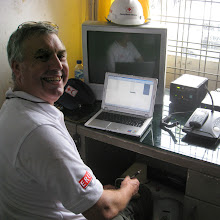I had first thought that the language spoken in Indonesia was Bahasa. I got educated today by my interpreter and, the news is - everyone in the world speaks bahasa because bahasa simply means language - and everyone here speaks at least one language. In our case we speak bahasa Ingres (English) and for Indonesia the official language is bahasa Indonesia (Indonesian). Locally, in Aceh Province, they also speak bahasa Aceh (Acehnese). So, if someone asks “Can you speak bahasa?” simply reply “Of course!”
Now a test to see if you can speak bahasa Indonesia. Look at the following list of words and see how many of them you understand. I think you’ll be surprised.
Foto
Fotocopy
Brokoli
Computer
Laptop
Kamera,
Coklat (In Indonesian the “c” is pronounced like “ch”)
Es krim (think Baskin & Robbins)
Hamburger
Radio
Taksi
Villa
Violet
Video
And you thought you could only speak English. I'm learning a few phrases to get me by and, at a minimum, allow me to say hello and goodbye. Greeting someone can be confusing because you have to know what the time of day is. There are five different expressions. They are 'pagi pagi' (before 7:00am), 'pagi' (7:00am until 11:00am), 'siang' (11:00am until 3:00pm), 'sore' (3:00pm until 7:00pm), and 'malam' (after 7:00pm). If you want to say "See you tomorrow." you have to include the appropriate word for the time of day you expect to see them.
One of the things that still makes my brain spin is the number one. The Indonesian work for one is 'satu' which is pronounced like 'sah-two'. As soon as I hear the second syllable I’m already one numeral too much.
And, if you are wondering about the title, the Indonesian word for water is 'air' and is pronounced like 'ah-ear'.
Two final words to leave you with, that tickle my western funny bone: Doorsmeer and Pispot. Doorsmeer means carwash - do you want your doors smeared? and Pispot is a store that sells car parts - not what you were thinking.



























